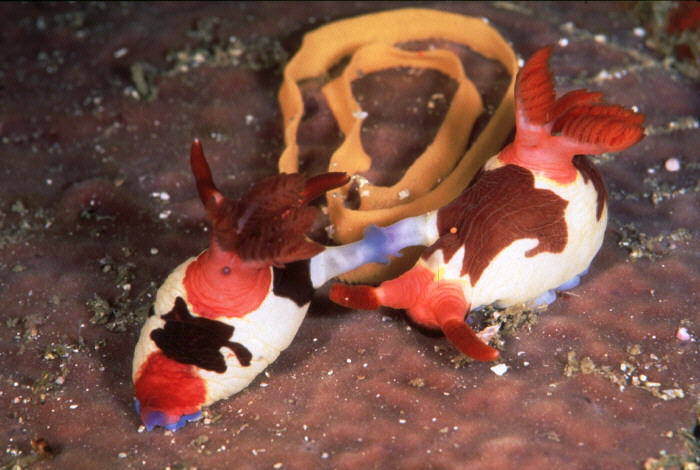 |
Nembrotha rutilans
Courtesy of Niki Dantine
Nembrotha rutilans (Pruvot-Fol, 1931)
Not only a great photo of a great species, but a special photo scientifically as it clearly describes the entire story of how this species carries out the procreation process. As a primer to what is to follow, uninitiated readers may want to refer to BOW #69 for an introduction to the wonderful world of nudibranch sex! And you won't even need a credit card for admittance!
As most of you are aware all nudibranch species are hermaphroditic, that is every individual is has both male and female reproductive organs. Having all the necessary plumbing doesn't mean an individual can self fertilize itself, so it still takes two to tango. What you can clearly see here in Niki's terrific photo are two adult N. rutilans, aligned side by side, head to tail with their reproductive apertures connected. In the genus Nembrotha, species have spiny penal armature to insure that the two apertures remain tightly connected during copulation. See an SEM of this armature for Nembrotha chamberlaini. Each specimen passes sperm to the other, thereby fertilizing each other.
The final product of this activity, the resultant egg mass, can be seen is seen in the photo above the two copulating individuals. The duration of copulation varies from family to family and genus to genus, but for this Nembrotha species the act seems to take some time. As a matter of fact, my dives in the Philippines seem to suggest members of this genus do nothing but copulate.
Number of egg masses laid from each copulation, their size and even density of egg within the ribbon, vary with the size of the individual laying the ribbon, the time of year and whether or not it is subsequent ribbon laid since the most recent copulation.
It is interesting to note that sea slug and its egg mass are both
brightly colored, suggesting aposomatic, or warning coloration, but they are
quite different colors. I have often wondered about this difference.
I certainly would never advocate voyeurism to my fellow divers and slug
lovers, but Niki's shot here explains a behavior, not only of scientific
interest, but of personal interest as well.
Danville, Calif
Feb. 2000

This shot of a "family scene" was taken in Indonesia just off the coast of Komodo Island. The conditions were not ideal as the water was roiled up and quite surgy, but I couldn't resist trying to capture what I thought was a rare nudibranch moment! I only had two shots left on my roll of film and got lucky! The camera was a Canon F1 with a 105 lens - Velvia film - Two strobes.
You can drop Niki a note at NDantine@aol.com
|
Webmaster's Note: Several of my fish photographer buddies who in the past would never be caught dead taking a picture of a nudibranch have finally come around and recognized the "art form" that branch photography can take. Niki's photo not only embodies this concept but tells the reproductive story of the animal and it's all in one 35 mm slide! A truly extraordinary photo in my estimation! I knew instantly when Steve Drogin first presented this image to me as a referral that it belonged on the site. I want to express my gratitude to Niki for making this wonderful contribution and to Steve for making it possible. As it turns out, Steve was the photographer for the original Nembrotha rutilans presentation.
Taxonomic information courtesy of Dave Behrens

David W. Behrens
Author:
Pacific Coast Nudibranchs
Send Dave mail at seachalleng@earthlink.net
|
